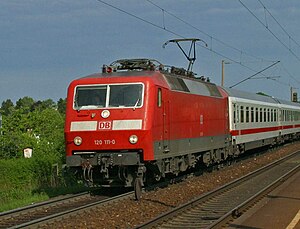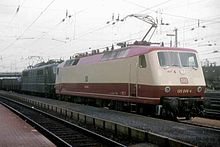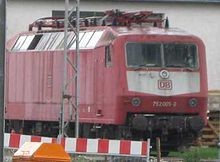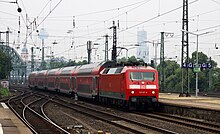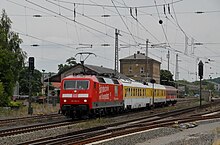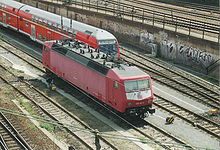DB class 120
| DB class 120 | |
|---|---|
|
120 111 in Fuerth
|
|
| Numbering: | on delivery: 120 001–005 120 101–160 due to later modification: 120 201–208 120 501–502 |
| Number: | 65 |
| Manufacturer: | BBC , Henschel , Krauss-Maffei , Krupp |
| Year of construction (s): | 1979–1980 (120.0) 1987–1989 (120.1) |
| Retirement: | since 2016 / until 2020 (DB Fernverkehr) |
| Axis formula : | B 0 'B 0 ' |
| Gauge : | 1435 mm ( standard gauge ) |
| Length over buffers: | 19,200 mm |
| Height: | 3,930 mm |
| Width: | 3,000 mm |
| Bogie axle base: | 2,800 mm |
| Total wheelbase: | 13,000 mm |
| Service mass: | 84.0 t |
| Wheel set mass : | 21.0 t |
| Top speed: | 200 km / h |
| Continuous output : | 4 × 1,400 kW = 5,600 kW |
| Starting tractive effort: | 340 kN 290 kN (120 137 to 120 160) |
| Performance indicator: | 66.6 kW / t |
| Driving wheel diameter: | 1,250 mm |
| Power system : | 15 kV 16.7 Hz AC |
| Power transmission: | Overhead line , single-arm pantograph SBS65, later SBS80 |
| Number of traction motors: | 4th |
| Drive: | Hollow shaft cardan single axle drive |
| Brake: | electrical; KE-GPR, multi-release, with cleaning brake; Spring-loaded brake |
| Train control : | Sifa , Indusi , LZB |
The class 120 is an electric locomotive series of the Deutsche Bahn AG . It is considered to be the world's first series-built three-phase AC locomotive in the high-performance range with a converter in semiconductor technology and is a milestone in the development of electric locomotives. In its time it represented the latest development of the three-phase drive, in which the three-phase current to drive the asynchronous traction motors is obtained from the alternating current of the contact line in traction converters . Based on the technology of the 120 series, the first ICE power cars were developed in the mid-1980s . On July 5, 2020, almost all of the class 120 locomotives still in service were parked. However, a locomotive of this series still operates on the Hanse Express RE 1 Rostock – Hamburg.
history
The drive of the 120 series is based on the three-phase asynchronous motor , which, from a railway technology point of view, is characterized by its significantly lower weight, more compact installation dimensions and lower maintenance costs than the single-phase series motor . In addition, it can withstand high loads, even when standing, because it has no commutators .
After three-phase current with a fixed voltage and frequency from two- or three-pole contact lines was used to drive rail vehicles from 1899 , modern semiconductor technology was able to generate three-phase current in the vehicle itself using frequency converters from the 1960s . The motor power is regulated directly by variable voltage and variable frequency. The Deutsche Bundesbahn gained its first experience with three-phase drive technology from 1971 with the DE 2500 series diesel-electric test vehicles from Henschel . The diesel engine and generator were removed from one of these locomotives, the 202 002, and the locomotive was permanently coupled to a BDnrzf 740.2 control car . The control car took over the power supply of the locomotive; for this purpose it was specially equipped with a transformer and a pantograph. In this way, a three-phase electric locomotive could be simulated.
The tests carried out with the combination in 1974/1975 were extremely successful and showed that the universal locomotive desired in anticipation of lower maintenance costs and downtimes was technically feasible. It became possible, which had been the wish and goal of the developers since the beginning of the locomotive construction: The locomotive could in principle replace all electric locomotives in operation at the time and move any type of train, no matter how heavy or how fast. DB wanted to achieve this with the E 10 as early as the early 1950s . At that time, however, this was not yet possible with AC drive, which led to the split into express train locomotives (E10) and freight locomotives (E40 / E50). The prospect of a universally usable locomotive led in 1976 to the development order for the Bo'Bo 'class 120 electric locomotive. Consortium partners were BBC for the electrics, as well as Krauss-Maffei , Krupp and Henschel for the vehicle part.
In 1976, with the Henschel E 1200, the first small series of three-phase locomotives for the mining and port railways of Ruhrkohle AG was put into service. The knowledge gained with these six locomotives was incorporated into the development of the 120 series.
The pre-series locomotives class 120.0
On May 14, 1979, the first locomotive with three-phase drive technology, the 120 001-3, was handed over to what was then the Deutsche Bundesbahn . It was initially approved for a top speed of 160 km / h and then practically tested at the Nürnberg Rbf depot. By January 1980, her sisters were extradited 120 002–005; the visually slightly different 120 005 (with a lower kink on the front and an initial paneling on the roof and around the buffers) was approved for a maximum speed of 200 km / h from delivery. The visual appearance of the 120 series was characteristic of the "face" of the Deutsche Bundesbahn in the 1980s and was used in the 240 and 628 series vehicles as well as the S-Bahn control car and the control car of the n-car with the so-called "Wittenberger head" continued. The repair shop in Frankfurt am Main built a sample of the 120 series from the buffer to behind the first bogie to check the design. Such a process is not known from any other Deutsche Bundesbahn locomotive.
The prototypes were given the purple / ivory TEE paint from the 1950s.
On August 13, 1980, the 120 002 locomotive set a new world record for three-phase vehicles at 231 km / h between Celle and Uelzen ( Hanover – Hamburg line ).
The three-phase drive technology and the electrical regenerative braking system, which is much more efficient thanks to the use of traction converters (the locomotive feeds energy back into the catenary during electrical braking) were completely convincing, but the locomotives' transformers could still be improved and were replaced by modified designs during the test phase.
The new series was officially presented on October 17 and 18, 1984. On October 17, 1984, the 120 001-3 reached a speed of 265 km / h in front of a special train with a trailer load of 250 t between Augsburg and Donauwörth. In the presence of numerous guests of honor, including Transport Minister Dollinger , the vehicle set a new world speed record for three-phase vehicles . For this purpose, the gear ratio and the windscreen were changed and the speedometer scale replaced. The top speed was reached after a three-minute drive. In 1985 this locomotive was converted for a record run. As part of a cooperation project between DB and SNCF, track and running gear parameters were to be harmonized between the two railway companies. The machine essentially received new drive motors with which it should reach speeds of up to 280 km / h. The record locomotive was the first vehicle of the series to be scrapped in 2004 after a serious accident.
During the four-year field trials, the five locomotives covered a total of around four million kilometers.
The development costs of the 120 series are given as approximately 100 million D-Marks. The then Deutsche Bundesbahn carried 60 percent of this.
The series 120.1 locomotives
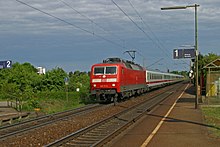
After four years of testing, a total of 60 series 120.1 locomotives were ordered in 1984 at a unit price of 5.5 million German marks . In April 1985, Federal Transport Minister Werner Dollinger approved the procurement of the last 24 of a total of 60 locomotives. In doing so, he redeemed an option from the purchase agreement, which in addition to the stipulated delivery of 36 locomotives, provided an option for 24 additional machines. The total investment was 380 million D-Marks. All locomotives should have been delivered by the end of 1988.
The prototypes of the series machines can be visually recognized by the four filler nozzles for the sand storage containers now located in the frame, which are triangular in the series machines and hung directly on the frame. In the pre-series models, the sand storage containers were smaller and integrated in the bogie.
The technical changes compared to the prototypes were minor, for example the electrical resistance brake built in as a fall-back level was omitted because the regenerative brake had proven to be reliable, contrary to initial expectations. For this, the locomotives received an additional high-voltage filter, which made two additional roof lines necessary. These were retrofitted to the pre-series locomotives. Viewed critically, the mechanical weaknesses of the pre-series models of the 120.0 series were also retained in the series. After successful tests with the prototypes 120 001 to 004 approved for a maximum of 160 km / h and the 120 005 already approved for 200 km / h, the series locomotives could be approved for up to 200 km / h.
On January 13, 1987, the industry in the Bundesbahn repair shop in Munich-Freimann handed over the 120 103, the first series three-phase locomotive to what was then the Deutsche Bundesbahn. Federal Transport Minister Werner Dollinger and Federal Railroad Board Member Reiner Gohlke attended the symbolic handover of the keys . The delivery of the series locomotives lasted until the end of 1989. They were put into regular service immediately, hauling Intercity and Interregio trains during the day and fast freight trains at night in a streamlined schedule .
The locomotives 120 137 to 120 160 were delivered with a modified gear ratio in order to obtain a higher tractive effort at high speeds. However, this change results in less pulling force at low speeds.
Assignments at DB AG
In the course of the third stage of the rail reform, the locomotives were added to the long-distance transport division (later DB Reise & Touristik , now again DB Long- Distance Transport), so that use in freight transport is now restricted. Some machines were converted to the class 120.2 and used by DB Regio .
Pre-series 120.0
Over the years, the five pre-production locomotives were repeatedly used together with the other 120s in scheduled service, but most of the time they served as rail service vehicles (they also got new numbers and became the 752 series) or as test vehicles for new technologies that were then used for the first time in series production of new electric locomotives in the late 1990s. These included B. disc brakes that could not previously be used in locomotives due to lack of space, or new bogies and converters for the 101 series . The test locomotives were stationed at the Federal Railway Central Offices in Minden and Munich.
When developing the 101 series , ABB Henschel used the 120 004 and 005 to help. ABB Henschel did not have a modern prototype, just a concept called Eco2000 and a technology demonstration based on the two converted pre-series 120s, which were already 15 years old.
The development of components for the Eco2000 relied on the pre-series locomotives of the series 120, 120 (or 752) 004 and 005, which were converted by ABB in 1992 in order to be able to test new technologies in practice. The 120,005 had new power converter on the basis of GTO thyristors received and a new on-board electronics 120 004 In addition, the ICE adapted bogies, disc brakes , the integrated total drive (IGA) and a biodegradable polyol - ester as a coolant for the main transformer. In this configuration, both locomotives covered large distances in scheduled IC service without any disruptions. 120 004 can be regarded as the prototype of the 101 series due to the complex modifications.
Since the beginning of 2002 none of the pre-production 120s has been in regular service. 120 003 belongs to the Nuremberg Transport Museum . It is currently (2011) in the Bahnpark Augsburg . 120 001 was destroyed as 752 001 in a serious accident in 2004 and dismantled on site, and 120 002 alias 752 002 had to be scrapped on May 17, 2005 after an accident in the Nuremberg AW. The 752 005 was loaned to the Weimar Railway Museum after the investigation period had expired , only 752 004 was the last to be used by DB Systemtechnik from Munich for test drives. In October 2011 she also left DB Systemtechnik's workforce. Since the beginning of June 2012 the machine can be viewed in the DB Museum Koblenz-Lützel.
Series 120.1

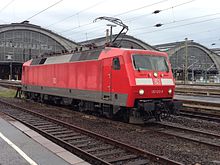
The pressure-capable vehicles of the 120 series were initially primarily used on the tunnel-rich southern section of the Würzburg – Fulda section of the new Hanover – Würzburg line , which was opened in May 1988 , as there were not yet enough pressure-capable vehicles available. The high level of damage initially proved to be problematic, as a result of which up to 35 percent of the 120 fleet were not available in August 1988. In addition, the locomotives from 120 136 had problems with the wheel protection boxes, which delayed the commissioning of further vehicles.
The 120 series was primarily used in IC traffic. Since the machines in the first few years of use z. Some of them were overstrained (long-distance passenger transport during the day, heavy freight trains at night), the reliability has lately decreased significantly, frame cracks and other serious damage occurred more frequently.
In 2007 the 120 series was considered to be well employed. In three schedules, 37 locomotives were used primarily in intercity traffic, but also as a supplement to the newly established 200 km / h Munich-Nuremberg Express , but only rarely in front of freight trains.
The first series machines 120 - 120, 110, 158 and 159 - which were withdrawn from operational service and which were used as spare parts dispensers, later returned to operational service due to the increased demand. 120 158 (as of January 2011) is still used as a spare parts dispenser; The machine was z- zipped on June 16, 2010 and after a long period of standstill in Munich is now in the Dessau repair shop to remove further parts. As a result, 49 locomotives were still in operation in January 2011, compared to 41 on July 1, 2016.
Five locomotives, which had already been parked in Hamm since 2016, were transferred to Opladen for scrapping at the beginning of 2018.
The 120 series has not been used by DB Fernverkehr since July 2020.
Conversion variant 120.2
| Redesign of the 120.2 series | |
|---|---|
| old locomotive number | new locomotive number |
| 120 116-9 | 120 201-9 |
| 120 129-2 | 120 202-7 |
| 120 107-8 | 120 203-5 |
| 120 128-4 | 120 204-3 |
| 120 121-9 | 120 205-0 |
| 120 117-7 | 120 206-8 |
| 120 136-7 | 120 207-6 |
| 120 139-1 | 120 208-4 |
The class 120.2 with five machines based in Rostock and five new double-decker cars each form a push-pull train of the Hanse Express . The route is part of the "Baltic Sea Coast" subnet.
Because of the increased driving dynamics values (five instead of four cars), five locomotives of this series were equipped with a local transport package (train destination display, train dispatch system, server, etc.) for the first time in 2007 and included in the 120.2 series with a new, consecutive serial number (201 to 205) . With a maximum of 160 km / h they travel the Rostock – Schwerin – Hamburg route. The Federal Railway Authority had initially refused approval for the 120.2, so that class 112 locomotives (mostly in so-called sandwich operation: one locomotive at the top and one at the end) were used here until spring 2008.
At the end of 2010, three more machines with the new serial numbers 120 206 to 208 (formerly 120 136, 139, 117) were handed over to DB Regio Rheinland (later DB Regio NRW ) and their home is in Aachen. They were used in North Rhine-Westphalia on the Rhein-Sieg-Express . At times these machines were shut down due to increased breakdowns. Since the five Rostock machines were also regularly bottlenecks due to various damage and deadlines, the three Aachen machines also alternately supported the Rostock stock. In spring 2013, 120 207 and 208 were again in action from Aachen, while 120 206 continued to help out in Rostock. Use of the series on the Rhein-Sieg-Express ended in October 2018. 120 201 was sold to Bahnlogistik24 on November 6, 2018; This makes it the first class 120 locomotive operated by a private railway company.
Conversion variant 120.5
120 153 and 120 160 were sold to DB Systemtechnik at the beginning of 2005 and subjected to a general overhaul of the IS 703 at the Nuremberg plant (NNX). The locomotives were given different locomotive numbers. 120 153 became 120 501 and 120 160 became 120 502. Both locomotives are used with test and measuring trains throughout Germany. During the 2006 soccer world championship , the locomotives were loaned to DB Fernverkehr and were used before regular trains. Even today it can happen that a 120.5 is used in front of a long-distance train when there is a lack of locomotives. 120 502 was painted yellow in 2013 to match the measuring car. With 120 125, a third class 120 locomotive has been part of DB Systemtechnik since the beginning of 2016. Since September 2016, the two locomotives 120 501 and 502 are again referred to as 120 153 and 120 160.
DB class 121 and successor
When the timetable changed on December 11, 2005, DB AutoZug had acquired some class 120 locomotives from DB Fernverkehr in order to use them for motorail trains . The locomotives continued to be based in Munich, but the planned change to the 121 series was only made on the 120 113 before the machines were returned to DB Fernverkehr due to increased demand.
A follow-up model for the 120 planned as the 121 series was not implemented, although two prototypes had already been tested (since the 121 series was to be kept free, these drove as the 127 001 and 128 001 ). The original concept of the 120 from the 1980s as a universal locomotive became less important as a result of the rail reform , as the DB's independent divisions favored vehicles specially tailored to their respective needs for cost reasons.
The former hope of the Deutsche Bundesbahn was never ordered in the intended numbers. However, the power cars of high-speed trains are ICE 1 and ICE 2 is a direct evolution of the Series Locomotive 120. In addition, she was the inspiration for the current generation of new high-power electric locomotives, from the 101 series on the Series 152 (development of the 127,001 ) to the series 145 (Further development of 128 001 ).
construction
The electrical equipment
Behind the four separate secondary windings of the main transformer, the electrical engineering differs significantly from everything that previously existed on German rails. An oil-cooled traction converter , which consists of the following assemblies, is connected to each secondary winding :
- Four-quadrant controller (hereinafter abbreviated 4q-S )
- DC - DC with absorption circuit and back-up capacitor
- Pulse inverter ( PWR )
Two traction converters each are interconnected and jointly supply the two motors of a bogie . The single-phase voltage on the secondary side of the transformer is converted into DC voltage by the 4q-S. In the intermediate circuit with a nominal voltage of 2800 V (maximum permissible: 3200 V) there is a suction circuit tuned to 33 1/3 Hz and a backup capacitor. The pulse inverters are fed from the intermediate circuit and generate the three-phase alternating current with variable voltage (0–2200 V concatenated ) and frequency (0.4–150 Hz) for the traction motors. The 4q-S are each offset by 90 ° with 183 Hz - 11 times the mains frequency - clocked, the clock frequency of the asynchronously clocked PWR is a maximum of 200 Hz up to a motor frequency of 20 Hz. Above 20 Hz, synchronized clocking methods are used to To avoid fluctuations in the motor current. Since a 4q-S and a PWR are basically constructed in a very similar way, the reverse working direction also works, which is used with the electric brake of the locomotive: The PWR then feeds the DC link with the three-phase current generated by the motors, and the 4q From this, -S generates single-phase alternating current again, which is fed into the contact line.
On the roof there are two single-arm pantographs of the type SBS 80. This was developed from the standard single-arm pantograph SBS 65 and could be used up to 250 km / h (SBS 65 only up to 200 km / h). The construction was 90 kg lighter than the SBS 65 and had better suspension to ensure safe contact even at high speeds. Since the 120 series was originally only intended as a test vehicle, some things were done differently in the vehicle part than previously: For the first time, the main transformer could be arranged under the vehicle floor, which made it possible to keep the engine room very clean and tidy and with a straight line to equip a continuous central aisle. The entire vehicle part is characterized by extensive lightweight construction, which initially also caused problems. The large gear wheels and gear boxes in particular were too light, and there were frequent breakages and oil leaks until these parts were replaced by stronger ones. The conventional design with pivot pins was used for the bogies. The secondary suspension of the drives is Flexicoil coil springs over that can automatically reset back to centered position the bogie for a cornering and lateral movements of the locomotive body allow. Power is transmitted to the wheels by a hollow shaft universal joint drive from BBC ; the mass of the traction motors is completely cushioned by the bogie.
In terms of auxiliary operation, the 120 series also broke new ground: for the first time, a three-phase auxiliary network was used which, in addition to smaller motors, also enables the auxiliary operations to be controlled.
The 120 series has three auxiliary converters (HBU), which are fed via the auxiliary winding of the main transformer. HBU 1 and 2 each supply the two traction motor fans of a bogie as well as an associated transformer oil cooler fan. The engine speed is flexibly regulated by the HBU depending on the cooling requirement.
The third HBU works with a fixed frequency and supplies other auxiliary services, such as B. the transformer oil pumps. The air compressor is also supplied via the HBU 3. To enable problem-free start-up, the HBU 3 is shut down briefly when the air compressor is switched on.
The locomotive automatically monitors all relevant temperature values. If the limit values are exceeded despite fully regulated auxiliaries, a traction lock is issued.
Braking system
In addition to the electric brake, the locomotives also have a continuous, indirectly acting, multi-release compressed air brake of type KE-GPR with a direct additional brake for shunting. When the locomotive is braking, it is usually only the electric brake that acts; the compressed air brake is pre-controlled and is only used if the e-brake fails.
In contrast to the electrical resistance brakes of the standard locomotives, the braking force does not decrease with decreasing driving speed, but rather the electric brake can work with full force up to a standstill thanks to the three-phase drive technology. In order to improve the static friction on the rail, especially under bad weather conditions, a so-called "cleaning brake" was installed later, which applies the block brake with 0.25 bar brake cylinder pressure when the E-brake is in operation . This is intended to roughen the wheel treads, which leads to improved traction and braking. A spring-loaded brake is used as the holding brake .
Driver's cab
The DB standard driver's cab, used for the first time in the 111 series, was pressure-tight on the 120.1 series from the time it was delivered so that the locomotives could also be used on the new lines; the 120.0 were retrofitted accordingly. Pressure-protected interiors are important at high speeds, because when trains meet the outside air is strongly compressed by trains approaching each other at high relative speeds , often at over 400 km / h, especially in tunnels, which in the worst case can cause hearing damage. Therefore, all vehicles used there must meet pressure protection requirements.
Safety device
In addition to the prescribed safety package , consisting of safety driving control (Sifa), point train control including line train control (LZB80 / I80 with PZB 90), GSM-R train radio , an automatic driving and brake control (AFB), as well as control devices for the electropneumatic train brake (ep ) and the emergency brake override Nbü-DB via IS (so that an emergency braked train does not come to a stop in the tunnel, but only behind it). Computers for the electronic book timetable EBuLa were retrofitted . Since delivery, all locomotives can be used in both double traction (ZDS) and push-pull trains (ZWS). The time-division multiplex push-pull train control was used here for the first time, which is why, until the 101 series came into operation, they were the only locomotives that were allowed to push control car- driven IC trains at speeds of up to 200 km / h. The pre-series machines also had the conventional push- pull train control , which enables use with push-pull trains, e.g. B. made possible from n-cars .
Color variations
In order to improve the aerodynamics , 120 005 received a slightly different front compared to the other four locomotives in the pre-series. The kink in the front section typical for the series , which was also the colored dividing line between red and beige, has been drawn further downwards. For this reason, the red stripe on the side had to be beveled towards the driver's cab, which made it unmistakable.
Starting in 1987, the 60 series 120.1 series locomotives commissioned were given, as the only DB series ex works, the newly introduced Orient red color scheme (RAL 3031) with a front, white warning surface, which railway workers refer to as a bib becomes. The warning area on the respective front side extends from the bend to the lower edge of the window front. Later this area was set off with an orient red stripe below the windshield. As part of investigations and repairs, both paintwork variants were used, although there were occasional minor deviations in shape and size.
With the introduction of the traffic red color scheme from 1996, more and more locomotives received the new, current color scheme.
The 120 502 from DB Systemtechnik, which was used in front of the yellow painted test vehicle, was painted yellow in 2013 to match the test vehicle.
Also due to the large open space of this series, the 120 series is often used as an advertising, art or anniversary locomotive. So z. B.
| 120 002 | AEG - Innovative technology for the sake of the environment | (1993) |
| 120 004 | 1. High-performance locomotive with disc brakes DB / ABB | (1996) |
| 120 129 | Märklin Christmas locomotive | (1996) |
| 120 139 | Art locomotive Teun Hooks / Märklin | (1997) |
| 120 141 | Advertising locomotive Dresdner Bank Investment Group | (1997) |
| 120 151 | ZDF express advertising locomotive | (1997) |
| 120 119 | Anniversary locomotive 70 years of Mickey Mouse, Walt Disney Company / Märklin | (1999) |
| 120 102, 110, 118, 120, 122-124, 126, 133, 138, 140 | Advertising locomotive from the state of Baden-Württemberg | (2000) |
| 120 501, 502 | DB system technology | (2005) |
| 120 159 | Anniversary locomotive 150 years of Märklin | (2008) |
| 120 159 | Anniversary locomotive 175 years of the railway | (2010) |
| 120 112 | Märklin My World | (2012) |
Retirement and preserved locomotives
Due to the technical progress in the field of rail vehicle technology, the 120 series is now considered obsolete and is increasingly prone to failure. Of the former five prototypes, only the 120 003 in the Bahnpark Augsburg, the 120 004 in the DB Museum Koblenz Lützel, and the 120 005 at the TEV in Weimar are now available. The 120 001 was scrapped after a total write-off accident. The 120 002 served its sister machines as a spare parts donor and was then also scrapped.
A small fleet of the 120 series ran until July 2020 according to the schedule on the Stuttgart – Karlsruhe and Stuttgart – Nuremberg routes, whereby the number of use of the 101 series - which is actually intended as a standard locomotive for long-distance trains - significantly exceeded that of the 120 series.
Part of this fleet were among others: 120 108-6, 120 111-0, 120 114-5, 120 118-5, 120 123-5, 120 133-4, 120 134-2, 120 147-4, 120 148- 2, 120 155-7, 120 157-3 and 120 159-9.
The number of series machines at DB is steadily declining. The first series locomotives have already been scrapped. Other locomotives were sold.
As planned, the last run of the series at DB Fernverkehr 120 took place on July 5, 2020 as IC 2161 from Stuttgart to Munich . As of July 2020, the class 120 is in use at DB Regio Nordost in the Hanse Express (RE 1) between Rostock and Hamburg.
Location and inventory of the class 120 locomotives (as of August 2020):
| Vehicle number
(91 80 6xxx xxx-x) |
Operator designation | operator
( NVR designation) |
comment |
|---|---|---|---|
| 120 001-3 | 120 001-3 | DB | red / beige "TEE paint", disassembled (05/25/2004) sweeties |
| 120 002-1 | 120 002-1 | DB | orient red, dismantled (05/17/2005) AW Nuremberg |
| 120 003-9 | 120 003-9 | DB | red / beige "TEE paint", not operational |
| 752 004-2 | 120 004-7 | DB | red / beige "TEE paint", not operational |
| 752 005-9 | 120 005-4 | DB | orientrot, permanent loan to Thüringer Eisenbahnverein eV Weimar , not operational |
| 120 101-1 | 120 101-1 | DB | traffic red, DB Museum Koblenz, not operational |
| 120 102-9 | 120 102-9 | DB | traffic red, parked in Munich , not operational |
| 120 103-7 | 120 103-7 | DB | traffic red, parked Hamburg-Eidelstedt plant , spare parts dispenser, not operational |
| 120 104-5 | 120 104-5 | DB | traffic red, parked SSM Leipzig-Engelsdorf , not operational |
| 120 105-2 | 120 105-2 | DB | traffic red, parked in Munich, operational |
| 120 106-0 | 120 106-0 | DB | traffic red, disassembled (08.2017) AW Dessau |
| 120 203-5
(formerly 120 107-8) |
120 203-5 | DB | traffic red, operational |
| 120 108-6 | 120 108-6 | DB | traffic red, parked SSM Leipzig-Engelsdorf, operational |
| 120 109-4 | 120 109-4 | DB | traffic red, dismantled (11.12.2015) Depot Munich |
| 120 110-2 | 120 110-2 | DB | traffic red, disassembled (08.2017) AW Dessau |
| 120 111-0 | 120 111-0 | DB | traffic red, parked in Munich, operational |
| 120 112-8 | 120 112-8 | DB | traffic red, disassembled (23.04.2018) from Bender, Opladen |
| 120 113-6 | 120 113-6 | DB | traffic red, parked SSM Leipzig-Engelsdorf, not operational |
| 120 114-4 | 120 114-4 | DB | traffic red, parked SSM Leipzig-Engelsdorf, operational |
| 120 115-1 | 120 115-1 | DB | traffic red, parked SSM Leipzig-Engelsdorf, not operational |
| 120 201-9
(formerly 120 116-9) |
120 201-9 | BLC | traffic red, operational |
| 120 206-8
(formerly 120 117-7) |
120 206-8 | DB | traffic red, parked SSM Leipzig-Engelsdorf, not operational |
| 120 118-5 | 120 118-5 | DB | traffic red, parked in Munich, operational |
| 120 119-3 | 120 119-3 | DB | traffic red, parked SSM Leipzig-Engelsdorf, operational |
| 120 120-1 | 120 120-1 | DB | traffic red, parked in Munich, operational |
| 120 205-0
(formerly 120 121-9) |
120 205-0 | BLC | traffic red, operational |
| 120 122-7 | 120 122-7 | DB | traffic red, parked SSM Leipzig-Engelsdorf, not operational |
| 120 123-5 | 120 123-5 | DB | traffic red, parked SSM Leipzig-Engelsdorf, operational |
| 120 124-3 | 120 124-3 | DB | traffic red, disassembled (09.04.2018) from Bender, Opladen |
| 120 125-0 | 120 125-0 | DB | traffic red, operational |
| 120 126-8 | 120 126-8 | DB | traffic red, parked SSM Leipzig-Engelsdorf, not operational |
| 120 127-6 | 120 127-6 | DB | traffic red, parked Cologne , operational |
| 120 204-3
(formerly 120 128-4) |
120 204-3 | WRSCH | traffic red, operational |
| 120 202-7
(formerly 120 129-2) |
120 202-7 | DB | traffic red, operational |
| 120 130-0 | 120 130-0 | DB | traffic red, disassembled (04.2016) AW Nuremberg |
| 120 131-8 | 120 131-8 | DB | traffic red, disassembled (April 10, 2018) from Bender, Opladen |
| 120 132-6 | 120 132-6 | DB | traffic red, parked SSM Leipzig-Engelsdorf, operational |
| 120 133-4 | 120 133-4 | DB | traffic red, parked in Munich, operational |
| 120 134-2 | 120 134-2 | DB | traffic red, parked in Munich, operational |
| 120 135-9 | 120 135-9 | DB | traffic red, disassembled (09.04.2018) from Bender, Opladen |
| 120 207-6
(formerly 120 136-7) |
120 207-6 | DB | traffic red, parked SSM Leipzig-Engelsdorf, not operational |
| 120 137-5 | 120 137-5 | DB | traffic red, parked SSM Leipzig-Engelsdorf, not operational |
| 120 138-3 | 120 138-3 | DB | traffic red, disassembled (04/11/2018) from Bender, Opladen |
| 120 208-4
(formerly 120 139-1) |
120 208-4 | DB | traffic red, parked SSM Leipzig-Engelsdorf, not operational |
| 120 140-9 | 120 140-9 | DB | traffic red, disassembled (08.2017) AW Dessau |
| 120 141-7 | 120 141-7 | DB | traffic red, parked SSM Leipzig-Engelsdorf, not operational |
| 120 142-5 | 120 142-5 | DB | Orient red, disassembled (October 15, 2011) from Steil , Eschweiler-Aue |
| 120 143-3 | 120 143-3 | DB | traffic red, parked SSM Leipzig-Engelsdorf, operational |
| 120 144-1 | 120 144-1 | DB | traffic red, parked AW Dessau, not operational |
| 120 145-8 | 120 145-8 | WRSCH | traffic red, operational |
| 120 146-6 | 120 146-6 | DB | traffic red, parked in Munich, operational |
| 120 147-4 | 120 147-4 | DB | traffic red, parked in Munich, operational |
| 120 148-2 | 120 148-2 | DB | traffic red, parked SSM Leipzig-Engelsdorf, not operational |
| 120 149-0 | 120 149-0 | DB | traffic red, parked SSM Leipzig-Engelsdorf, not operational |
| 120 150-8 | 120 150-8 | DB | traffic red, parked in Munich, operational |
| 120 151-6 | 120 151-6 | DB | traffic red, parked SSM Leipzig-Engelsdorf, not operational |
| 120 152-4 | 120 152-4 | DB | traffic red, parked in Munich, operational |
| 120 153-2
(formerly 120 501-2) |
120 153-2 | DB | traffic red, operational |
| 120 154-0 | 120 154-0 | WRSCH | traffic red, parked Karlsruhe , operational |
| 120 155-7 | 120 155-7 | DB | Traffic red, "Aufgleislok" in Fulda , not operational |
| 120 156-5 | 120 156-5 | DB | traffic red, disassembled (April 10, 2018) from Bender, Opladen |
| 120 157-3 | 120 157-3 | DB | traffic red, parked SSM Leipzig-Engelsdorf, not operational |
| 120 158-1 | 120 158-1 | DB | orient red, disassembled (July 15, 2013) AW Dessau |
| 120 159-9 | 120 159-9 | DB | traffic red, parked in Munich, operational |
| 120 160-7
(formerly 120 502-0) |
120 520-0 | DB | yellow, operational |
literature
Books
- Karl Gerhard Baur: The 120 series. Volume 1 - Development and prototypes . Eisenbahn-Kurier Verlag, Freiburg 2014, ISBN 978-3-8446-6015-9 .
- Karl Gerhard Baur: The history of three-phase locomotives . Eisenbahn-Kurier Verlag, Freiburg 2005, ISBN 3-88255-146-1 .
- Christian Wolf: The class 120. The first three-phase electric locomotive of the DB . Eisenbahn-Kurier Verlag, Freiburg 2004, ISBN 3-88255-351-0 .
- 120, electric locomotive in three-phase drive technology for the German Federal Railroad . R. Oldenbourg Verlag, Munich 1984, ISBN 3-486-29001-0 .
Magazines
- Marcus Niedt: Farewell to the world champions. The 120.0 series . In: Lok-Magazin . 33rd volume, no. 248 . GeraNova Zeitschriftenverlag, Munich 2002, p. 36-47 .
- Horst J. Obermayer: The class 120 - a new generation of locomotives . In: Horst J. Obermayer (Ed.): Lok-Magazin . No. 130 . Franckh'sche Verlagshandlung, W. Keller & Co. , Stuttgart 1985, p. 23-28 .
- Ulrich Hesse: Braking tests with the 120 005 locomotive . In: Lok-Magazin . No. 109 . Franckh'sche Verlagshandlung W. Keller & Co., Stuttgart 1981, p. 263-264 .
- Jürgen Hörstel, Karl-Heinz Buchholz: Class 120 . In: Eisenbahn Journal Extra 2/2019 . Publishing group Bahn, Fürstenfeldbruck 2019, ISBN 978-3-89160-750-3 .
Web links
- The 120 series at www.elektrolok.de
- Revision data and statistics for the 120 series
- 120 005 - The chubby prototype
- modellbau-wiki: The BR 120 in a model
Individual evidence
- ↑ a b Appun, Futterlieb, Kommissari, Marx: The electrical design of the power converter equipment of the locomotive 12 0 of the Deutsche Bundesbahn , Electrical Railways EB, issue 10/82, p. 290 ff.
- ↑ a b Without an author: The further plans of the new railway . In: Bahn-Special , Die Neue Bahn . No. 1, 1991, Gera-Nova-Verlag, Munich, pp. 78-79.
- ^ J. Michael Mehltreter: The locomotives of the German Federal Railroad . 4th edition. Motorbuch Verlag, Stuttgart 1978, ISBN 3-87943-268-6 .
- ↑ Message 265 km / h - world record for DB three-phase current locomotive - also successful before a freight train . In: Railway technical review . 33, No. 11, 1984, p. 802.
- ↑ a b Message Presentation of the BR 120 locomotive - world record of 265 km / h for locomotives with three-phase drive technology . In: Railway technical review . 33, No. 11, 1984, pp. 861-862.
- ↑ a b W. Gottstein: BR 120 - At 265 kilometers per hour into the future . In: Internationales Verkehrwesen , Volume 36 (1984), p. 429.
- ^ The ICE and other future projects of the DB . In: Eisenbahn-Kurier , 20, No. 155, August 1985, pp. 30-33.
- ↑ a b c Report three-phase locomotive in series . In: Eisenbahntechnische Rundschau , vol. 36, no. 1/2, 1987, p. 2.
- ↑ Announcement 60 electric locomotives of the BR 120 . In: Railway technical review . 34, No. 5, 1985, p. 357.
- ↑ See series 101 .
- ↑ Electric locomotive (www.elektrolok.de)
- ↑ Annual review 1988 . In: Die Bundesbahn 1/1989, pp. 63–64.
- ↑ Notification of fast traffic still problematic . In: Eisenbahn-Kurier , issue 10/1988, p. 44.
- ^ LOK Report (Berlin), Edition 2/2007.
- ^ DB locomotives and railcars 2016 , EK-Verlag, Freiburg im Breisgau, August 2016, p. 13f
- ↑ a b http://mitteldeutschesbahnforum.xobor.de/t2522f5-Bahnbau-ihre-quot-Neuste-quot-in-Gelb.html 120 502 in yellow
- ↑ www.revisionsdaten.de - The ONLINE vehicle database on the Internet. Retrieved July 21, 2019 .
- ↑ BR 120 - list of locomotives. Accessed April 30, 2020 (German).
- ↑ Turntable Online Forums :: 01 - News :: Farewell trip of the BR 120 for DB FV. Retrieved July 5, 2020 .
- ↑ www.revisionsdaten.de - The ONLINE vehicle database on the Internet. Retrieved August 13, 2020 .
